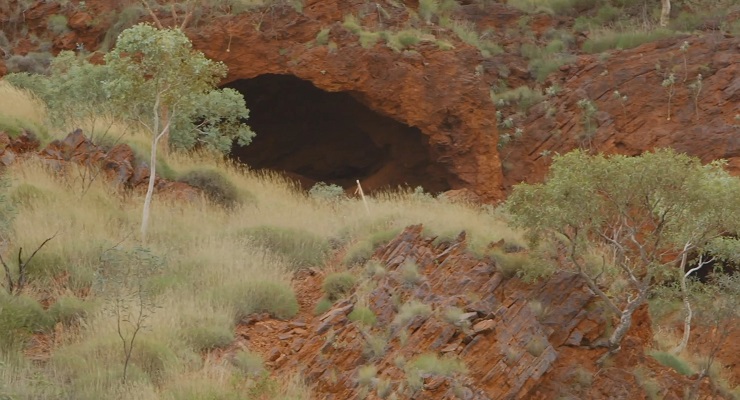
This is an abridged version of an article originally published on Arena.
“Never again” will we see the destruction of sites of such extraordinary antiquity and cultural significance as those at Juukan Gorge. So insists Warren Entsch MP in his emotionally charged foreword to the interim report of the Joint Standing Committee on Northern Australia’s inquiry into Rio Tinto’s destruction of the 46,000-year-old habitation sites belonging to the Puutu, Kunti, Kurrama and Pinikura (PKKP) peoples.
There is no reason to believe that this is anything other than heartfelt. Indeed, we believe that most Australians would “never again” want to see Australia’s version in 2020 of the destruction of the unique Buddhas of Bamiyan by the Taliban in 2001.
But there is little in this interim report, hyperbole aside, that fills us with any confidence that such destruction will not occur again. This is because such destruction is structurally embedded in the settler-colonial extractive logic on which the Australian nation was founded and on which it continues to prosper.
Emblematic of this, the country’s only broadsheet newspaper, The Australian, reported on the release of these preliminary findings and recommendations on page 5, while on its front page it noted that China’s 2020 trade hit list excludes iron-ore exports, valued at $84.8 billion, almost exclusively sourced from the Pilbara region.
Coverage in the Australian Financial Review predictably focused on the negative economic implications of the inquiry’s recommendations. WA Liberal Senator Dean Smith, a member of the joint committee, lamented that the report’s recommendation of a stay on the destruction of sites, as allowed under section 18 of the Aboriginal Heritage Act 1972 (WA), would “be a handbrake on the resources sector” — a view shared by the resources sector.
“Never again” is a catchcry that First Nations people in Australia have heard on many occasions: never again will we tolerate stolen generations, as child removal accelerates; never again will there be deaths in custody, as numbers in incarceration grow; never again will wages be stolen, as remote-living Indigenous unemployed people are subject to modern slavery-like conditions; never again will there be rationing of food, as the parliament debates and then passes punitive and racially targeted income-management measures.
History is replete with fine intentions and many “never agains”, articulated with great sincerity by politicians to Aboriginal and Torres Strait Islander peoples.
Much of the interim report, along with the media coverage that has followed its release, focuses on the particulars of Rio Tinto’s appalling corporate culture, actions and attempted cover-ups.
It is recommended first and foremost that Rio Tinto negotiate a restitution package with the traditional owners of Juukan Gorge, the PKKP peoples, for the destruction of the site, and that the obliterated habitation shelters be reconstructed. The latter is a preposterous idea. Even if such high-tech “plastic surgery” were possible, post-dynamite obliteration would result in a bizarre Disney-style avoidance of re-colonial reality.
Incrementally and systematically, the report moves from the particulars of Juukan Gorge and Rio Tinto up the responsibility food chain to the deficient Aboriginal Heritage Act, to the broader Western Australian experience of extraction and environmental and cultural-site destruction irrespective of the wishes of traditional owners; to the experience only briefly alluded to beyond Western Australia; to the apex Commonwealth laws — a tripartite layered set of legal arrangements covering Indigenous heritage: the ineffectual Environmental Protection and Biodiversity Conservation Act 1999 (EPBC Act); the Aboriginal and Torres Strait Islander Heritage Protection Act 1984 (ATSIHP Act) that has remained largely dormant during the Juukan debacle; and the overriding Native Title Act 1993 that was carefully designed to ensure that holders of native-title rights and interests are rendered impotent to oppose mineral extraction.
The interim report quickly summarises the legal and administrative shortcomings of the EPBC Act and the ATSIHP Act and identifies the main role of the Native Title Act in heritage protection as arising through agreement making. This is because holders and claimants of native title are only vested with a “right to negotiate” over extraction, with no right to veto.
The extent of the bias inherent in this agreement-making process is revealed in the interim report: just three of 163 so-called “future act” applications have been successfully opposed in Western Australia under native-title law.
Even this is superior to the protection afforded to Indigenous owners under the prevailing WA legislation: of the 463 applications lodged by mining companies to destroy sites of significance under section 18 of the Aboriginal Heritage Act since 2010, not one has been rejected.
The report’s language is stronger than many and its consideration of the need for the provision of free, prior and informed consent to Indigenous owners is commendable in intent. This might reflect the composition of the joint committee, which includes several members who have championed Indigenous rights on many occasions. Yet ultimately the recommendations to date contain very little that might move Australia towards the report’s stated, titular intention, “never again”.
Instead, it issues words of “encouragement” and requests for voluntary improvements to a set of agencies antithetical to the Indigenous interests they are now being “encouraged” to protect: from Rio Tinto to other mining companies in the Pilbara, all the way through to the WA government (whose coffers are filled with royalties from those same companies), to a federal government that continues to participate in and benefit from ongoing processes of invasion and dispossession.
By focusing on the particulars of Juukan Gorge and Rio Tinto, the interim report is looking to apply a sticking plaster when serious suturing is required.
Is it possible for representatives of the Australian parliament, established by invader constitutional fiat that asserts its own sovereign powers (including to own and extract mineral wealth in corporate and national interests), to adequately represent pre-existing sovereign interests?
There are competing, arguably irreconcilable logics at play here, one dominant, one subordinate: will the Australian settler state ever willingly engage in its own recalibration?
Ensuring “never again” will require a new logic, one that overturns the prioritisation of rampant mineral extraction (be it iron ore, gas or coal) irrespective of any economic gains and ensures that corporations that transgress non-negotiable heritage protocols are punished with the automatic loss of their licence to operate — not merely socially, but legally as well.
This will require an Australian state that properly prioritises the Indigenous interest over the so-called “national interest”. Sadly, nothing in living memory suggests that any government is up to embracing such a challenge.
Jon Altman is an emeritus professor at the School of Regulation and Global Governance, Australian National University. Dan Tout is a lecturer in history at Federation University.








… Maybe Ken Wyatt will make a stand against what his party is doing, and what he’s been party too?
Ken Who?
Aussie “Uncle Tom.”
a) don’t blame the victim, and
b) don’t shoot the messenger,
please:)
He’s not a victim, more a messenger – like Quisling or Pétain.
Obedient to HMV.
“…settler logic…”
Now there’s an oxymoron if there ever was one.
463 to Nil. Nil. Zero. Nothing. All I can write is that I am sorry. And angry. People who purport to represent me and continue to vandalise/destroy these most important places deserve to burn in hell. My words against their ampho. But we’re all armed with a vote, too. “Never Again” vote for these pricks, is my advice. I hope this is printable, can’t think of anything less furious to write.
Of course it will happen again the country side is littered with sacred sites wherever the wandering tribes left some graffiti – even the sophisticated Lascaux cave paintings going back 30,000 years still are not classed as sacred sites but based upon reality they are classed as historical – and as such recognised by UNESCO as unique. Our tendency is to even preserve tribal discarded food rubbish dumps as sacred sites rather than looking at the anthropological significance of the tribal culture.and where they fitted into thee survival of the peripatetic cultures of the various tribes.
Your provocative attempt to use “wandering” as a pejorative suggests that you need, firstly, a dictionary and, secondly, to study the concept of transhumant societies – try the Swiss or Austrians if you need to stay behind your white picket fence.
In relation to ‘never again’, you really should read the fine print.
Never again will we be caught destroying aboriginal sacred sites.
There, fixed.